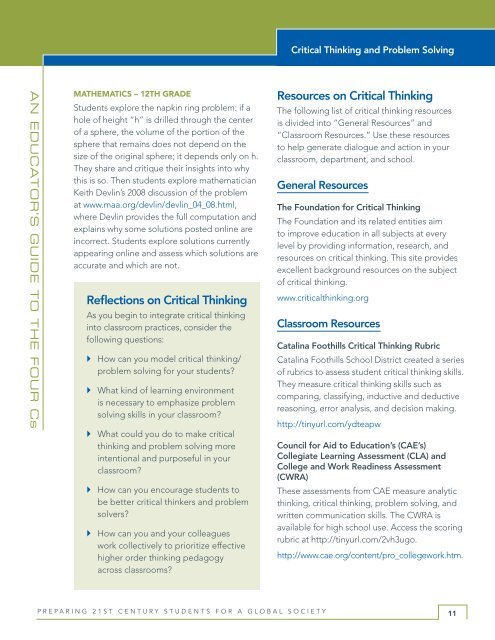Preparing 21st Century Students for a Global Society
Preparing 21st Century Students for a Global Society
Preparing 21st Century Students for a Global Society
Create successful ePaper yourself
Turn your PDF publications into a flip-book with our unique Google optimized e-Paper software.
An EducAtor’s GuidE to thE Four cs<br />
MAthEMAtiCs – 12th GRAdE<br />
<strong>Students</strong> explore the napkin ring problem: if a<br />
hole of height “h” is drilled through the center<br />
of a sphere, the volume of the portion of the<br />
sphere that remains does not depend on the<br />
size of the original sphere; it depends only on h.<br />
They share and critique their insights into why<br />
this is so. Then students explore mathematician<br />
Keith Devlin’s 2008 discussion of the problem<br />
at www.maa.org/devlin/devlin_04_08.html,<br />
where Devlin provides the full computation and<br />
explains why some solutions posted online are<br />
incorrect. <strong>Students</strong> explore solutions currently<br />
appearing online and assess which solutions are<br />
accurate and which are not.<br />
Reflections on Critical Thinking<br />
As you begin to integrate critical thinking<br />
into classroom practices, consider the<br />
following questions:<br />
` `How<br />
can you model critical thinking/<br />
problem solving <strong>for</strong> your students?<br />
` `What<br />
kind of learning environment<br />
is necessary to emphasize problem<br />
solving skills in your classroom?<br />
` `What<br />
could you do to make critical<br />
thinking and problem solving more<br />
intentional and purposeful in your<br />
classroom?<br />
` `How<br />
can you encourage students to<br />
be better critical thinkers and problem<br />
solvers?<br />
`<br />
` How can you and your colleagues<br />
work collectively to prioritize effective<br />
higher order thinking pedagogy<br />
across classrooms?<br />
P r e P a r i n g 2 1 s t C e n t u r y s t u d e n t s f o r a g l o b a l s o C i e t y<br />
Critical Thinking and Problem Solving<br />
Resources on Critical Thinking<br />
The following list of critical thinking resources<br />
is divided into “General Resources” and<br />
“Classroom Resources.” Use these resources<br />
to help generate dialogue and action in your<br />
classroom, department, and school.<br />
General Resources<br />
The Foundation <strong>for</strong> Critical Thinking<br />
The Foundation and its related entities aim<br />
to improve education in all subjects at every<br />
level by providing in<strong>for</strong>mation, research, and<br />
resources on critical thinking. This site provides<br />
excellent background resources on the subject<br />
of critical thinking.<br />
www.criticalthinking.org<br />
Classroom Resources<br />
Catalina Foothills Critical Thinking Rubric<br />
Catalina Foothills School District created a series<br />
of rubrics to assess student critical thinking skills.<br />
They measure critical thinking skills such as<br />
comparing, classifying, inductive and deductive<br />
reasoning, error analysis, and decision making.<br />
http://tinyurl.com/ydteapw<br />
Council <strong>for</strong> Aid to Education’s (CAE’s)<br />
Collegiate Learning Assessment (CLA) and<br />
College and Work Readiness Assessment<br />
(CWRA)<br />
These assessments from CAE measure analytic<br />
thinking, critical thinking, problem solving, and<br />
written communication skills. The CWRA is<br />
available <strong>for</strong> high school use. Access the scoring<br />
rubric at http://tinyurl.com/2vh3ugo.<br />
http://www.cae.org/content/pro_collegework.htm.<br />
11


